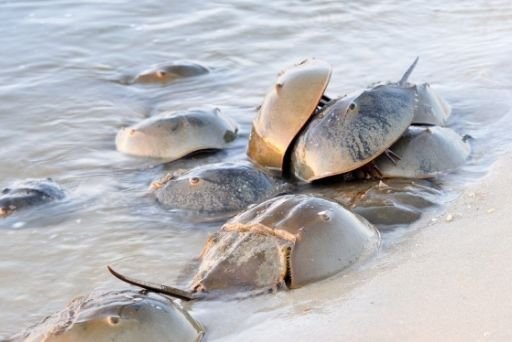All about the Horseshoe Crab: the marine living fossil
The earth is full of some fascinating creatures that are so old that they originated in prehistoric times. Given their old origin date and their primordial appearance, these creatures are referred to as “living fossils”. Horseshoe crabs are one of the most well-known living fossils, since they first came into being more than 244 million years ago. They can be found in marine and brackish areas primarily – and they belong to the family Limulidae, which is a branch of arthropods.

History & origin of the Horseshoe Crab
Horseshoe crabs evolved along with a group of prehistoric marine arthropods that are known as trilobites, because of their 3 lobe body structure. Although the trilobites went extinct towards the end of the Paleozoic Era, the horseshoe crabs managed to survive even until today. The term “crab” is actually a misnomer, since the horseshoe crab is not even a real crab or even a crustacean. They’re called crabs because of their marine/brackish habitats.
In fact, you will be surprised to know that the horseshoe crab is closer in relation to mites, ticks, and spiders than they are to crabs. Now, there are 4 surviving species of horseshoe crabs – which can be found in India, Japan, North America, and Indonesia. The North American variety of the horseshoe crab, also known as Limulus polyphemus, is pretty well-known to most people who live near the American coasts. They’re used as fishing bait in the East Coast.

Anatomy of the Horseshoe Crab
The horseshoe crab has a very primordial and rudimentary appearance – consisting of a complex underbelly that lies under a hard upper shell or carapace. This species has 9 eyes – a pair of compound lateral eyes that are each made out of 1000 ommatidia, a pair of median eyes that can be used to detect UV light, a pair of rudimentary lateral eyes, one endo-parietal eye and a pair of ventral eyes close to the mouth.
The vision capabilities of horseshoe crabs are very interesting, since their eyes are more than a million times more sensitive to light during the night. They also have very large rods and cones in their ommatidia. They’ve a pair of small appendages known as chelicerae to shove food into their mouth. They also have 5 pairs of appendages called pedipalps, which they use for moving around. The horseshoe crabs have a molting season every year where they shed the exoskeleton.

PHOTO BY TIMOTHY FADEK – BBC NEWS
Medical use of Horseshoe Crabs
Did you know that horseshoe crabs have copper-based blood? This means that the crabs use haemocyanin to transport oxygen to their cells. Their blood also contains a type of mobile cell called “amebocyte”, which has tremendous importance in medical fields. The blood of the Atlantic horseshoe crab is harvested to extract amebocytes, which finds application in the making of a type of reagent known as LAL or Limulus Amebocyte Lysate. LAL is used to detect bacterial endotoxins.
The horseshoe crab blood is also in high demand, since LAL is one of the most useful and important reagents in the field of pathology. There is an entire industry that collects them, collects their blood, and then releases them back into the ocean. If kept in the right conditions, horseshoe crabs can survive for 4-5 days without water. However, many scientists don’t believe that the crabs are returned to the sea at all by the LAL pharmaceutical companies.

Sustainable alternative to Horseshoe Crab blood
In 1986, researchers from Kyushu University discovered that the bacterial endotoxin detection test could be taken care of by using an enzyme called Limulus clotting factor C or rFC. rFC is an ideal candidate for the test, since the enzyme is found in LAL itself. In 2003, a researcher known as Jeak Ling Ding patented a process for obtaining the rFC enzyme synthetically. Pathologists are now moving away from LAL to rFC endotoxin testing.

CONSERVATION
Interesting facts about Horseshoe Crabs
- The oldest discovered fossil of a horseshoe crabs has been shown to be more than 450 million years old, dating back to the late Ordovican period. This makes them one of the oldest living fossils.
- Horseshoe crabs have also been shown to swim upside down. They swim on their backs and actually use their gills as paddles. They can also scuttle along the sandy floor of the brackish or oceanic floors that they live on.
- Like other living fossils, horseshoe crabs take a lot of time to grow and mature. They can live for more than 20 years, and they take nearly 10 years to reach sexual maturity. Young crabs molt more than 16 times.
This is all of the information that you need to know about this fascinating creature that you’ll be able to find on any East Coast beach. They might not look like much, but they are one of the oldest and most fascinating and useful creatures that you can find.




